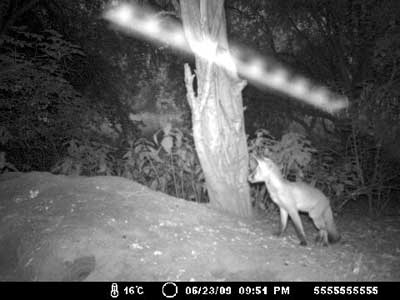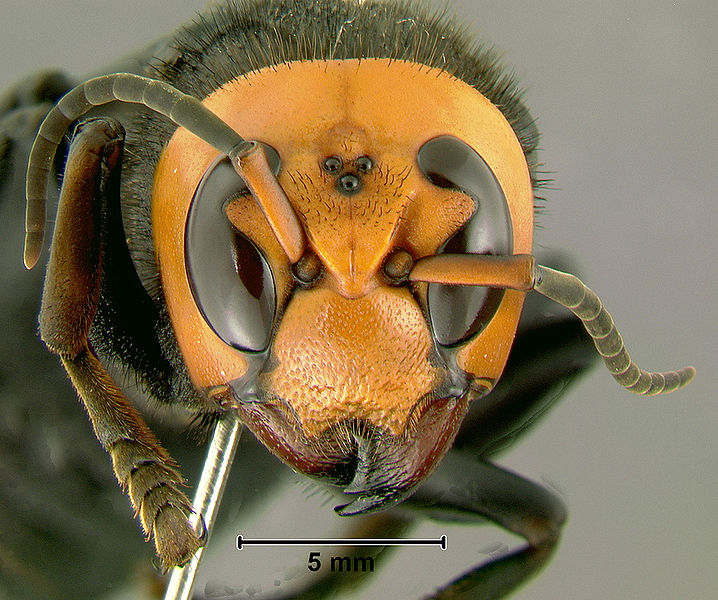What the fox that?
- Complaining about the Mainland - 17th August, 2024
- New island designation – is it just greenwash? - 26th April, 2024
- Police and Crime Commissioners – a solution or a problem? - 21st April, 2024
The Ranger received an intriguing email recently from Naturenet reader and amateur freelance nature photographer Russell Edwards. It contained the following image.

Russell explains:
I observe a badger sett in Suffolk and for this purpose use a “game” camera which is triggered by any movement in front of the camera. The camera works 24 hours a day and during the night takes pictures by infra red. It was while monitoring a fox family that this picture of a UFO appeared. I’ve been trying to work out what caused it apart from little green men from Mars. There are 10 wing beats. The shutter speed was a 1/10 of a second making it 100 beats per second. By measuring the dimensions of the tree I calculated the length of the track to be about 10 feet. That is 10 feet in a 1/10th of a second, 33 yards a second which is about 67mph.
Intriguing! So, what could it be? Russell’s done some good detective work here, and it certainly seems as though some flying animal went by, with a wingbeat of 100Hz (hertz = beats per second). Whether it really was going at 67mph is less certain, as it’s unclear how close to the tree it passed. If it was near the camera, the distance travelled (and thus the speed of passage) would be less than if it was further away. The only known fixed point is the tree, and it obviously passed in front of that. It’s also clear that it’s very out of focus, so probably it’s not very close to the tree. Beyond that we can’t be sure. So, there are three possibilities for things flying by in a Suffolk woodland. Birds, bats and insects. Let’s check these out by wingbeat. I’ve had trouble finding much data about bird wingbeats but this paper by C.J. Pennycuick, 1990 gives a table of some (pretty large) birds’ wingbeats ranging from 3Hz to about 10Hz. Far from 100Hz. Even a hummingbird might only have a wingbeat of up to 60Hz, although some are apparently faster at times. But I think we can safely assume that there are no hummingbirds in a dark Suffolk woodland. So probably not a bird, then. From a 2002 paper on Australian bats by R.D. Bullen and N.L. McKenzie, we can suppose a typical wingbeat for a bat of between 5Hz and 12Hz. Again, nowhere near 100Hz. So that leaves insects. The frequency range in insects with synchronous flight muscles typically is 5 to 200 hertz, which makes 100Hz right in the midrange. Mind you, in those with asynchronous flight muscles (which includes beetles and flies), wing beat frequency may exceed 1000 Hz. That this UFO was an insect was my instinct, and also that of professional ecologist Ian Boyd of Arc Environmental Consultants, who kindly advised me on this conundrum. Ian wrote:
Got to be an insect surely? Maybe a gnat/fly, something small and fast.
So, there’s the best I can do – it’s an insect. Probably a lot closer to the camera than it appears, too. But beyond that it’s hard to say. Ian joked to me “Maybe it’s a phantom, a visitor from the other side…” I think we can discount that, but who knows? All theories, however outlandish, are welcomed.


Assuming it is a moth, about 2cm in size, it has been picked up about 10 times so the track is about 20cm, which is why it is so out of focus. 20cm in 1/10s = 2m/s (2 yards/s or 6mph) which doesn’t seem to fast for a moth.
I pick them up all the time on my badger cam (http://www.ourbadgers.co.uk/), along with spiders who seem to think just infront of the camera is a good place for a web! I only get single images though, probably down to differences in camera/software
ITS A BAAAAAAAAT
Of course one prediction this theory makes is that the light should go on and off in a sine wave pattern. The pattern of the ‘wingbeats’ in the photo is not a million miles from this. Unfortunately the path of a wingtip in flight is also not dissimilar, so that doesn’t really prove anything.
Was there an IR light being used to assist the camera? Was it mains powered? Wouldn’t 100 beats or peaks a second correspond to 50Hz? Given the object doesn’t seem to significantly change shape could it be assumed that these aren’t wing beats and we’re looking at a fairly unchanging shape being highlighted 10 times in 1/10s?
The Ranger responds: an excellent hypothesis and at least as credible as the alternatives. The light is indeed infra-red and I assume the IR was LED generated as is normally the case these days, so does anyone know enough about LED physics to comment?
In 2004 I volunteered with some ecologists monitoring bear populations in northern Greece, using extensive camera traps. Amongst non-bear things caught on camera, we got illegal immigrants sneaking over the border from Albania, plenty of curious shepherds, but, suprisingly often, the picture would just be filled with small white balls. It was very odd, the Greeks joked about it being “ghosts” and you do wonder..!
I support the insect theory. That is if there isnt any Loch Ness monster photo trickery or such involved.
My opinion a moth very close to the lens
I think it’s a chicken owner throwing a stick at the fox.